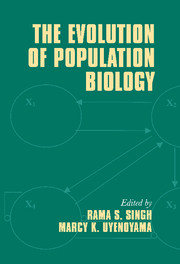Book contents
- Frontmatter
- Contents
- List of contributors
- Publications of R. C. Lewontin
- Preface
- Introduction
- Part I Historical foundations and perspectives
- Part II Genotypes to phenotypes: new genetic and bioinformatic advances
- 3 Genetic dissection of quantitative traits
- 4 Gene expression profiling in evolutionary genetics
- 5 Population biology and bioinformatics
- 6 Beyond beanbag genetics: Wright's adaptive landscape, gene interaction networks, and the evolution of new genetic systems
- Part III Phenotypes to fitness: genetics and ecology of populations
- Part IV Genes, organisms, and environment: evolutionary case studies
- Part V Applied population biology: biodiversity and food, disease, and health
- Index
6 - Beyond beanbag genetics: Wright's adaptive landscape, gene interaction networks, and the evolution of new genetic systems
Published online by Cambridge University Press: 08 January 2010
- Frontmatter
- Contents
- List of contributors
- Publications of R. C. Lewontin
- Preface
- Introduction
- Part I Historical foundations and perspectives
- Part II Genotypes to phenotypes: new genetic and bioinformatic advances
- 3 Genetic dissection of quantitative traits
- 4 Gene expression profiling in evolutionary genetics
- 5 Population biology and bioinformatics
- 6 Beyond beanbag genetics: Wright's adaptive landscape, gene interaction networks, and the evolution of new genetic systems
- Part III Phenotypes to fitness: genetics and ecology of populations
- Part IV Genes, organisms, and environment: evolutionary case studies
- Part V Applied population biology: biodiversity and food, disease, and health
- Index
Summary
Introduction
Diversity and evolutionary innovation are the hallmarks of life. Life appears to defy the laws of physics and chemistry and it does so with the help of energy. Life succeeds by finding ways to overcome natural and physical hindrances. Life spread over the face of the globe and filled almost every crevice and habitat. Of course there are limits to what evolution can do. Everything is not possible. For example, there must be a limit to how tall California redwoods can grow just as there must have been a limit to the size of dinosaurs. Although life's success appears almost boundless and has had continued success for more than four billion years, there are no general laws describing the limits of evolution. This is in contrast to physical and chemical laws that define constraining limits. The grandest experiment of nature, the evolution of life, has no theory equivalent to E = mc2.
The basic forces of evolution, both intrinsic (mutation, migration, sexuality, selection, and random genetic drift) and extrinsic (historical contingency and major catastrophe), generate not a single outcome but a range of possibilities.
- Type
- Chapter
- Information
- The Evolution of Population Biology , pp. 104 - 136Publisher: Cambridge University PressPrint publication year: 2004

